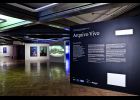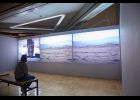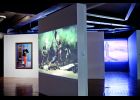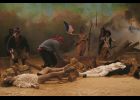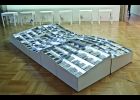Priscila Arantes
MIS [Museum of Image and Sound] São Paulo, Brazil
Priscila Almeida Cunha Arantes (https://sitepriscilaarantes.wordpress.com) is an art critic, curator, researcher, university professor, and cultural manager. She holds a degree in Philosophy from the University of São Paulo (USP) and a Master’s and PhD in Communication and Semiotics from the Pontifical Catholic University of São Paulo (PUC-SP), where she currently serves as a professor in the Department of Arts, coordinator of the Master's Program in Arts and Cultural Practices, and associate director of the Faculty of Philosophy, Communication, Languages, and Arts. Her academic work is notable for research and supervision focused on the intersections of art and technology, with an emphasis on curatorial narratives, archives, and artistic practices of resistance. From 2007 to 2020, she served as the artistic director and curator of Paço das Artes, where she conceived and consolidated key programs such as Paço Comunidade and Performa Paço, expanding opportunities for artistic experimentation and public engagement. She also led significant efforts to strengthen institutional memory, with a focus on research and collection preservation, resulting in a curatorial trilogy dedicated to this theme — Arquivo Vivo, Para Além do Arquivo, and Mapa, the latter being a curatorial platform that brings together the entire trajectory of Paço das Artes’ Temporada de Projetos, including its exhibitions, artists, and documents.
Articles of Priscila Arantes
Entre a Memória e o Abismo: regimes de hipermemória, datificação e a arte como desprogramação na cultura de dados /Between Memory and the Abyss: Hypermemory Regimes, Datification and Art as Deprogramming in Digital Culture
This essay investigates transformations of memory in the context of digital culture, datafication, and algorithmic control, proposing the notion of a hypermemory regime to describe the contemporary reconfiguration of how memory is produced, stored, and monetised. Structured in three interconnected parts, the text begins by critically examining how memory has become a strategic field of dispute in the age of surveillance capitalism. Through the commodification of data and algorithmic governance, memory is no longer merely a human or cultural attribute—it is now central to new systems of power and behavioural control. In the second part, the essay turns to Vilém Flusser’s philosophical contributions—especially the texts Ars Memoria, Vampyroteuthis Infernalis, and Filosofia da Caixa Preta [Towards a Philosophy of Photography]—to rethink the technical, symbolic, and ideological dimensions of memory. Flusser’s reflections anticipate many of today’s central concerns and offer critical tools for understanding the mediating role of artificial memories. Finally, the third part explores how art, through gestures of deprogramming, can act as a space of resistance within the hypermemory regime. For Flusser, to remember is not only to preserve but also to invent—to reopen experience to imagination, criticism, and freedom.
Programing the Visible: Dialogues between Vilém Flusser and Harun Farocki
The 2016 São Paulo exhibition “Programando o Invisível” [Programing the Invisible], showcasing works by the artist and filmmaker Harun Farocki (1944-2014), questioned the role of images in the 21st century, and particularly those images constructed by computer algorithms for video games. One of the videos in the exhibition captured the dialogue that took place between Farocki and Vilém Flusser (1920-1991) in 1986. In this theoretically rich and promising video, titled “Shocking sentences, shocking images: a conversation with Vilém Flusser,” they discussed the hegemony of images and of their power in programing our visibility. The theme is one of the central questions in both their works, as if the filmmaker and the philosopher were speaking about the same thing, although in different and complimentary ways. Their works similarly urge a reflection about the possibilities of creation of a critical perspective in face of our image culture, and they both emphasize the question of freedom in a society increasingly programed and dominated by technical images.
6 PHOTOGRAPHS: Partial views of the exhibition "Arquivo Vivo", Paço das Artes, 2013, curated by Priscila Arantes. Photos by Fernanda Frazão, courtesy of the Paço das Artes
Post-History, technical images and freedom in times of barbarism
Amongst the various media theorists who emerged in the last century, Walter Benjamin and Vilém Flusser are unquestionable references in regard to issues related to the narratives and the world of images. In addition to thinking about media devices and apparatuses beyond technical objects, both Benjamin and Flusser considered media images as concepts that articulate new epistemological and ontological views of the world.
On the other hand, it is possible to identify in both theorists thought processes that engage the concept of history with different perspectives. In line with critiques of a universal and hegemonic history, and without falling into an apologetic discourse about a presumed end of history, these authors offer us fresh perspectives in relation to historicism through a fruitful dialogue with the realm of technical images.
Post-history, technical images, and freedom in times of barbarism focuses not only upon contributions by Walter Benjamin and Vilém Flusser, but the article also examines the curatorial perspective of Arquivo Vivo, showcased at the Paço das Artes, in São Paulo, in 2013. This exhibition highlights the central position of art in the production of knowledge about images, history, and narratives within the framework of contemporaneity.
Fred Forest / Media, gestures and society. Dialogues between Vilém Flusser and Fred Forest
Mídia, gestos e sociedade. Diálogos entre Vilém Flusser
The present article proposes a dialogue between Vilém Flusser’s media theory, especially focusing upon his books Filosofia da Caixa Preta (1983) and Les Gestes (1999), and the artistic projects developed by the French multimedia artist Fred Forest. Each in his own way acted towards the creation of a critical and reflective spirit about the world seen as a “black box.”
